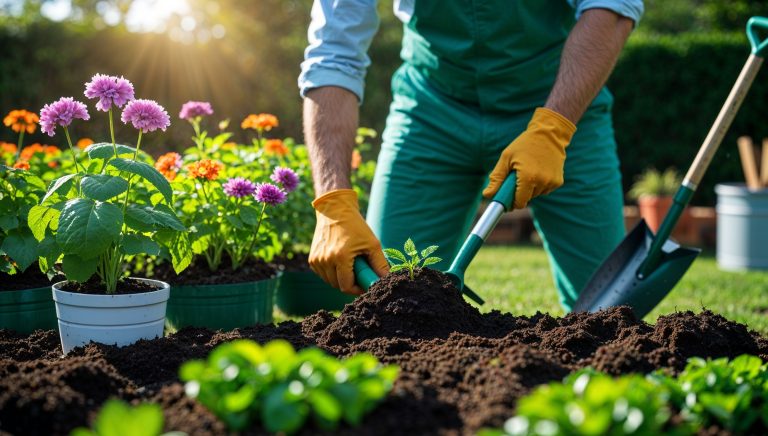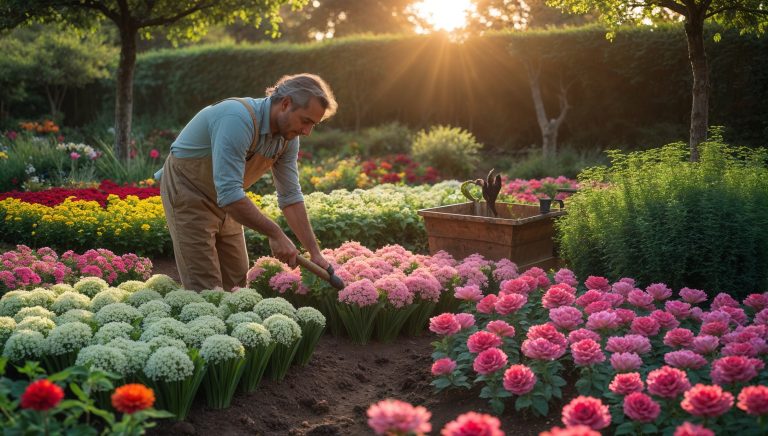

Creating a beautiful flower garden at home is a rewarding and enjoyable project that allows you to express your creativity and connect with nature. Whether you have a small patio or a large backyard, flowers can brighten up your space and provide a serene, colorful escape. In this article, we’ll walk you through the essential steps to successfully grow a stunning flower garden, from choosing the right flowers to caring for them.
The location of your flower garden plays a vital role in its success. Different flowers have varying sunlight and soil requirements, so selecting the best spot is crucial for your plants to thrive.
Flowers generally need at least 6 hours of direct sunlight per day to bloom and grow properly. If you have a sunny spot in your garden, it’s perfect for sun-loving flowers such as sunflowers, marigolds, and zinnias. However, if your garden is shaded or has areas that only receive partial sunlight, there are still plenty of flowers that thrive in these conditions, such as begonias, impatiens, and hostas.
Ensure that your soil is well-draining to prevent water from collecting around the roots, which can lead to root rot. If your soil is heavy and clay-like, mix in some organic matter, such as compost, to improve drainage and provide nutrients. Loamy soil is ideal for most flowers as it retains moisture while allowing for proper drainage.
Choosing the right flowers for your garden is essential to create a beautiful and sustainable space. Consider your climate, available space, and the look you want to achieve when selecting flowers.
One of the first decisions you’ll need to make is whether to plant annuals or perennials. Annual flowers complete their life cycle in one growing season, while perennials come back year after year. Annuals, such as petunias, pansies, and marigolds, provide vibrant color throughout the season but need to be replanted every year. Perennials like lilies, lavender, and peonies offer long-term beauty and will return year after year with minimal effort.
To create a visually appealing garden, choose flowers with varying colors, shapes, and textures. Mix bold colors like red, orange, and yellow with softer tones like pink, lavender, and white for a balanced, harmonious look. Consider adding flowers with different textures, such as the soft petals of roses paired with the spiky blooms of lavender or the delicate bell-shaped flowers of foxgloves.
Once you’ve chosen your flowers, it’s time to prepare the soil for planting. Healthy, well-prepared soil is the foundation for a successful flower garden.
Before planting, test the pH of your soil to determine if it is too acidic or too alkaline for the flowers you plan to grow. Most flowers prefer a slightly acidic to neutral pH, around 6.0 to 7.0. You can purchase a soil test kit or have a sample analyzed by a local garden center to get an accurate reading. If your soil is too acidic, you can add lime to raise the pH; if it’s too alkaline, adding sulfur will help lower it.
To improve soil quality, add organic matter like compost or well-rotted manure. This will help improve soil structure, increase nutrient availability, and promote healthy root growth. Mix the organic material into the soil to a depth of about 6-8 inches to ensure even distribution of nutrients.
Now that your soil is ready, it’s time to plant your flowers! Follow these steps to ensure your plants are properly placed and cared for.
Each flower has specific planting depth and spacing requirements, so be sure to check the seed packet or plant tag for the best recommendations. As a general rule, plant flowers at a depth that is twice the size of the seed or root ball. Space the plants according to the size they will reach at maturity to prevent overcrowding.
After planting, water your flowers thoroughly to help settle the soil around the roots. Make sure to water deeply, ensuring that the water reaches the root zone. Watering in the morning is ideal as it allows the plants to dry off during the day, reducing the risk of fungal diseases.
Maintaining a flower garden requires regular attention, but the rewards are well worth it. Here are some essential tips for keeping your flowers healthy and vibrant.
Flowers generally require regular watering, especially during dry spells. However, be careful not to overwater, as this can lead to root rot. Water the plants deeply once a week, or more often if the weather is particularly hot. Use a soaker hose or drip irrigation system to water the base of the plants directly, which prevents water from evaporating too quickly and reduces the risk of fungal diseases.
To keep your flowers healthy and blooming, fertilize them regularly. Use a balanced fertilizer with equal amounts of nitrogen, phosphorus, and potassium to promote strong growth and vibrant blooms. Be sure to follow the instructions on the fertilizer packaging to avoid overfeeding your plants, which can lead to weak growth or burnt roots.
Deadheading is the process of removing spent flowers to encourage new blooms and maintain a tidy garden. Simply pinch off the faded flowers at the base of the stem to promote continued flowering. Regularly prune any dead or diseased stems to improve air circulation and prevent the spread of pests and diseases.
A healthy flower garden is less likely to attract pests and diseases, but occasional issues can arise. Here are some common pests and ways to deal with them.
Aphids are common pests that can damage your flowers by sucking sap from the stems and leaves. To control aphids, try spraying your plants with a mixture of water and mild soap or neem oil. Be sure to spray in the early morning or evening to avoid harming beneficial insects like bees.
Fungal diseases, such as powdery mildew or black spot, can affect your flowers. To prevent fungal growth, ensure your flowers have good air circulation and avoid overhead watering. If you notice signs of disease, remove the affected leaves and dispose of them properly to prevent spreading the fungus.
After all your hard work, it’s time to enjoy the beauty of your garden. Spend time admiring the vibrant colors, textures, and scents of your flowers. Your flower garden can become a peaceful retreat, a place to relax, and a source of joy throughout the seasons.